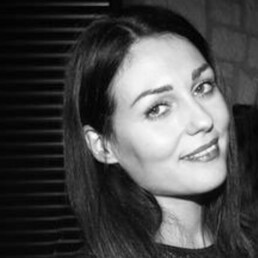Bosse (1971) by Georges Mathieu: A Calligraphic Work at Galerie Hurtebize in Cannes
Galerie Hurtebize in Cannes presents “Bosse” (1971) by Georges Mathieu, a pioneer of lyrical abstraction. Created using a mixed technique on paper, this work perfectly embodies the artist’s innovative spirit and technical mastery.
Georges Mathieu: A Master of Lyrical Abstraction
Born in 1921, Georges Mathieu has become a leading figure in lyrical abstraction, an artistic movement that favors spontaneity and emotional expression. In contrast to geometric abstraction, Mathieu favors immediacy and improvisation, creating works in which every stroke reflects pure, immediate emotion. His bold approach not only marked his era, but continues to inspire contemporary artists. His public performances, in which he painted gigantic works in a matter of minutes, captured worldwide attention and set new standards in the world of abstract art.
Description of work "Bosse" (1971)
“Bosse” is a perfect illustration of Georges Mathieu‘s lyrical abstraction. The work is composed of a set of very fine gold, black and white signs, arranged in such a way as to create a calligraphic harmony. Positioned in the center of a deep black background, this minimalist arrangement of lines and shapes induces an intense energy. The contrast of colors and the finesse of the strokes underline the artist’s dexterity and the depth of his artistic vision.
- Color Palette: The work uses a restricted palette of three colors – gold, black and white – which reinforces the visual and emotional impact of the composition. This deliberate limitation of colors highlights the brilliance of the golds and the sobriety of the blacks and whites, creating a captivating visual tension.
- Techniques used: Finely worked in gouache, every line and sign testifies to the artist’s speed of execution and freedom of gesture. This technique captures the immediacy of gesture and the fluidity of movement, making each work unique and spontaneous.
- Harmonious Layout: Signs are arranged to create a harmonious, balanced whole, evoking abstract calligraphy. This arrangement reveals a meticulously considered composition, where each element finds its place to form a coherent, expressive whole.
The Principles of Lyrical Abstraction
Georges Mathieu overturned theories of painting by defining four fundamental criteria for creating his works:
- Primacy of Speed of Execution: Speed captures the essence of the moment and expresses raw energy. This approach favors spontaneity, eliminating any form of calculation or rigid planning.
- No Pre-existence of Forms: Shapes are not predefined, allowing total creative freedom. This absence of prior structure gives rise to pure authenticity of artistic expression.
- No premeditation of gestures: Every gesture is spontaneous, reflecting the artist’s authenticity and sincerity. This method values instinct and raw emotion, as opposed to intellectualization and rigid technique.
- Necessity of a Second State of Concentration: The artist must achieve a state of intense, almost meditative concentration to create works of such intensity. This state enables the artist to transcend ordinary consciousness and access a deeper, truer form of expression.
The Calligraphic Period of Georges Mathieu
Prior to his flamboyant 80s period, often referred to as the “fireworks” period, Georges Mathieu explored a significant calligraphic phase. It was during this early period that Mathieu defined the foundations of his distinctive style. Influenced by oriental calligraphy, he developed a technique that blends speed and precision of gesture.
The influence of the Far East
In 1957, during a stay in Japan, Georges Mathieu came into contact with Japanese calligraphy and tradition, which considerably enriched his artistic approach. André Malraux had already described Mathieu as a “Western calligrapher” in 1950, establishing a link between his work and Far Eastern calligraphy. Mathieu was inspired by the calligraphy techniques used by Buddhist monks, where writing and ink painting are often inseparable.
The Calligraphic Nature of the Work
In the Far East, calligraphy is often imbued with a philosophical and spiritual aspect, in contrast to Western calligraphy, which is more focused on the aesthetics of beautiful writing. Mathieu has transcended this dichotomy by integrating the speed and spontaneity of Eastern calligraphy into his own work. In this sense, his works are not limited to mere aesthetics, but become a pure expression of emotion and energy.
Speed and Sign
Georges Mathieu bases his research on the abstraction of his signs. For him, the abstract sign denies any meaning prior to its creation, in contrast to traditional calligraphy where each sign has a precise meaning. In 1963, in his book “Au-delà du tachisme”, Mathieu explains that the background of his canvases takes on more uniform tones, making the signs more independent and precise. This rapidity of execution and spontaneity of gesture translates raw, immediate emotion, a principle that is repeated in “Bosse“.
Discover "Bosse" at Galerie Hurtebize
Galerie Hurtebize in Cannes invites you to discover “Bosse” and plunge into the expressive, dynamic world of Georges Mathieu. This unique piece is a true testament to his innovative artistic approach. “Bosse” is an invitation to feel Mathieu’s creative energy and appreciate the beauty of lyrical abstraction in all its splendor.

Céline Fernandez
With 15 years' experience in marketing and communications, Céline has worked for major companies such as Public Système, Groupe Galerie Lafayette and several communications agencies. For over 4 years, she has been managing the gallery's communications through the website, social networks and traditional media.


